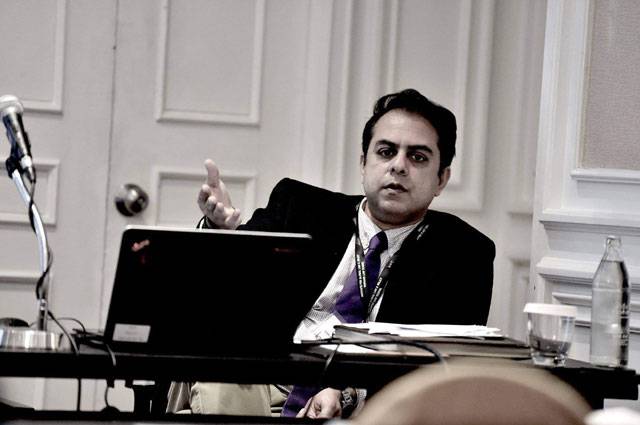Osama Siddique’s debut novel is spread over various areas of the Sub-Continent and also across several periods. It starts from two millennia prior to the start of Common Era in Mohenjodaro, moves over to Gandhara, has memorable stints in the Punjab of Mughal as well as Colonial eras, some contemporary stories set in and around Lahore and, eventually, also stares another seventy odd years into the future.
The great success of the narrative lies in how it causes the reader to be willingly teleported, time and again, from the serenity of a Buddhist Sangha in ancient Taxila to the cockpit of an AMPS (Airborne Monitoring and Patrol Scooter) in the future, and then back again to another completely different spatial surrounding infested with criminals, impostors and/or lawyers. The readers’ journey is not simplistically linear: instead the reader/traveller embarks on a unique experience that involves seamlessly entering and exiting several locations dotted over a large expanse of land and that too spread out over several epochs. Time is circular in the novel and so is the readers’ journey.
The locations are picturesque and diverse. The shelter of a great, tall tree provides solace as well as loftiness of thought to Prkaa during a heavy downpour - Prkaa, the pre-historic man who lived some four thousand years ago at a place referred to in the novel as the City of Bricks. From his chosen elevated habitat, he had the advantage of re-adjusting his moral compass with reference to the depraved inhabitants of the City. His love interest though didn’t see the need to adopt the methodology of climbing trees in order to develop a prescient disposition.
In another world, far away in time and space from the City of Bricks, it is a Buddhist monk, who from his relatively drier surroundings - which proceed to become drier still in subsequent centuries - prophesizes the end of the world as he and his companions know it. His ominous visions reveal the drawing of the curtain over yet another civilization in a long series of others also defaced and forgotten. What is particularly thrilling about the book is how the writer shows that in subsequent ages the monk’s beloved monastery would be visited by others characters too - characters who will live in the future - but for very different intents and purposes. Despite being a gifted seer even the monk cannot look so far into the future. But the reader does, with all the fascination and sense of wonder that a simultaneous reflection on the past, the present and the future brings with it. Places may remain the same but the people who live there or visit them, and also their motives and actions, could be quite different. Time and again Snuffing Out the Moon deftly connects the past, present and future and posits the overwhelming question as to whether the human experience shows evolution or stagnation. Thus, beneath the calm stone carved face of Lord Buddha is played out many a compelling story. As they are at various other significant places, with an ever-changing cast of compelling characters.
The novel puts forward several instances where natural elements or a pernicious priesthood threaten the very existence of a civilization. The latter, to my mind, is more sinister, capable as it is of inflicting torment and torture and not just annihilation. What is poignant though is how the author maintains hope and shows how despite disasters and dystopias humankind remains resilient - the moon is never quite snuffed out. The humanism of the book also lies in how the author rises above the divisions and demarcations of religion and sect - his preoccupation is with the victims, the suffering, the decimated, the survivors, and the dissenters. No matter who, or where or when.
A particularly satisfying part of the novel for me is the one dealing with the Colonial era. Quite apart from chronicling the valour of those who fought colonial hegemony it also exposes others who collaborated with the oppressor. The stories set in that era take a dig at all those princely families in our midst, whose contribution had been none other than boot licking the colonists. The novel shows also how despite their murky past they are the ones who continue to be revered, whilst the ones who lie dead in some forgotten pit with other freedom fighters are barely remembered.
The most interesting aspect of the book - perhaps due to the author’s own legal background - is the portrayal of contemporary lawyers. The callous and crafty characters that dominate the stage in the stories set in the current era are juxtaposed with the character of an honest, young female lawyer who tries to fight the exploitative system. It deserves mentioning here that the novel is refreshingly populated by many a strong female character. Ultimately, the novel provides a resounding indictment of the current system and society that we live in.
Snuffing Out the Moon is an ambitious enterprise by all standards: the multiple stories encompass scores of characters and several epochs and present a unique set of scenarios at almost every step. The immaculate description of clothes, the variations in language and its nuances, the different cultural and political contexts and resulting perceptions of the characters etc., all present many a challenge. The challenges have been successfully met and all the aforementioned aspects very skilfully handled. It is apparent that this enterprise would not have been possible for someone who does not share the author’s great wanderlust as well as his reading lust - if I may fashion that term. It is abundantly manifest in the detail and rigor with which he has contrived his various worlds, multiple characters and interlinked stories. This novel merits many visits and all of them will be pleasurable and thought-provoking.






